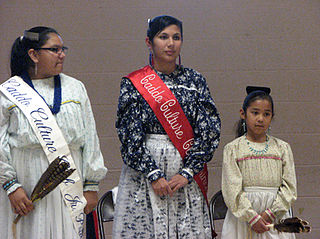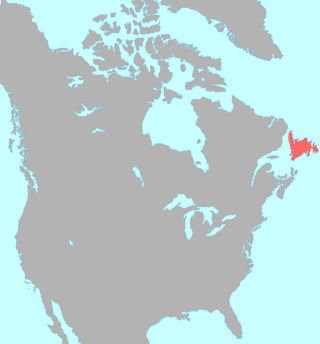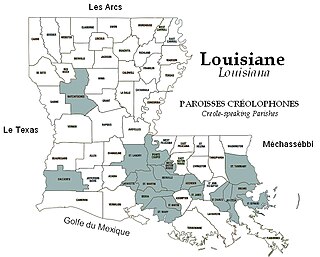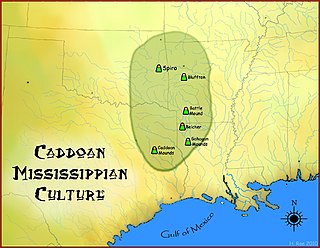
Robeline is a village in western Natchitoches Parish, Louisiana, United States. The population was 183 at the 2000 census. It is part of the Natchitoches Micropolitan Statistical Area.

The Caddo people comprise the Caddo Nation of Oklahoma, a federally recognized tribe headquartered in Binger, Oklahoma. They speak the Caddo language.

The Caddoan languages are a family of languages native to the Great Plains spoken by tribal groups of the central United States, from present-day North Dakota south to Oklahoma. All Caddoan languages are critically endangered, as the number of speakers has declined markedly due to colonial legacy, lack of support, and other factors.
Mandan is an extinct Siouan language of North Dakota in the United States.

Beothuk, also called Beothukan, is an extinct language once spoken by the indigenous Beothuk people of Newfoundland. The Beothuk have been extinct since 1829, and there are few written accounts of their language. Hence, little is known about it, with practically no structural data existing for Beothuk.

Louisiana Creole is a French-based creole language spoken by fewer than 10,000 people, mostly in the state of Louisiana. Also known as Kouri-Vini, it is spoken today by people who may racially identify as White, Black, mixed, and Native American, as well as Cajun and Creole. It should not be confused with its sister language, Louisiana French, a dialect of the French language. Many Louisiana Creoles do not speak the Louisiana Creole language and may instead use French or English as their everyday languages.

Comecrudan refers to a group of possibly related languages spoken in the southernmost part of Texas and in northern Mexico along the Rio Grande of which Comecrudo is the best known. These were spoken by the Comecrudo people. Very little is known about these languages or the people who spoke them. Knowledge of them primarily consists of word lists collected by European missionaries and explorers. All Comecrudan languages are extinct.
The Adai were a Native American people of northwestern Louisiana and northeastern Texas. They were an Indigenous peoples of the Southeastern Woodlands and part of the Caddo Confederacy.

Caddo is a Native American language, the traditional language of the Caddo Nation. It is critically endangered, with no exclusively Caddo-speaking community and as of 2023 only 2 speakers who acquired the language as children outside school instruction, down from 25 speakers in 1997. Caddo has several mutually intelligible dialects. The most commonly used dialects are Hasinai and Hainai; others include Kadohadacho, Natchitoches and Yatasi.

Los Adaes was the capital of Tejas on the northeastern frontier of New Spain from 1721 to 1773. It included a Franciscan mission, San Miguel de Cuellar de los Adaes, and a presidio, Nuestra Señora del Pilar de Los Adaes. The name Adaes derives from the indigenous Adai people, members of the Caddoan confederacy of Indians who were the people the missionaries aimed to convert to Christianity. The presidio and mission were established to counter French influence in Louisiana territory and defend New Spain from possible invasion or encroachment by the French. In 1763 Louisiana came under the control of Spain and the Los Adaes outpost was no longer necessary for defense. In 1773 the Spanish closed the mission and presidio and forced the population to move to San Antonio.

The Natchitoches meat pie is a regional meat pie from northern Louisiana, United States. It is one of the official state foods of Louisiana.
The Natchitoches are a Native American tribe from Louisiana and Texas. They organized themselves in one of the three Caddo-speaking confederacies along with the Hasinai, and Kadohadacho.
The Kadohadacho are a Native American tribe within the Caddo Confederacy. Today they are enrolled in the Caddo Nation of Oklahoma.
The Yatasi are Native American peoples from northwestern Louisiana that are part of the Natchitoches Confederacy of the Caddo Nation. Today they are enrolled in the Caddo Nation of Oklahoma.
The Eyeish were a Native American tribe from present-day eastern Texas.

The Caddoan Mississippian culture was a prehistoric Native American culture considered by archaeologists as a variant of the Mississippian culture. The Caddoan Mississippians covered a large territory, including what is now Eastern Oklahoma, Western Arkansas, Northeast Texas, Southwest Missouri and Northwest Louisiana of the United States.
The Choctaw-Apache Community of Ebarb, also known as the Choctaw-Apache Tribe of Ebarb, is a state-recognized tribe and nonprofit organization in Louisiana. The community describes themselves as the descendants of Choctaw and Lipan Apache people and is primarily based in the town of Zwolle, Louisiana, with powwow grounds in Ebarb, Louisiana, both of which are in Sabine Parish, Louisiana, where the group say they have lived since the early 18th century.

Isle Brevelle is an ethnically and culturally diverse community, which began as a Native American and Louisiana Creole settlement and is located in Natchitoches Parish, Louisiana. For many years this area was known as Côte Joyeuse. It is considered the birthplace of Creole culture and remains the epicenter of Creole art and literature blending European, African, and Native American cultures. It is home to the Cane River Creole National Historical Park and part of the Louisiana African American Heritage Trail.
Dr. Hiram F. “Pete” Gregory Jr. is an archeologist and professor of four-field anthropology at Northwestern State University in Natchitoches, Louisiana.
Anne des Cadeaux was a Native American slave who later became a free woman, devout Catholic, and respected colonist of Louisiana.











